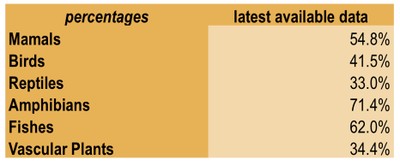Published: 26 Nov 2010
Modified: 17 Feb 2025
Luxembourg, despite its small size and the
fact of being a landlocked country, stands out because of its geological and
landscape diversity and species richness. From a socio-economic standpoint, Luxembourg is known for its economic prosperity, based on a flourishing
financial and service sector, and continued population growth, driven to a
large extent by immigration. The development of Luxembourg from a predominantly
rural economy, to a stronghold of the European steel industry and subsequently
a financial centre has been, and still is, the main driver of biodiversity
loss.
While the overall status of biodiversity is
still difficult to assess, national red lists, landscape statistics
and monitoring of selected species often show negative trends [Figure 1]. Indeed, roughly 55 % of mammals, 40 %
of birds, 30 % of reptiles, and 70 % of amphibians are currently
listed as endangered, while biodiversity-rich habitats such as wetlands, dry
meadows and extensively used orchards have seriously declined over the past 30
years [Figure 2]. Generally, biodiversity is in a better conservation status in forests
than in open, predominantly agricultural and aquatic ecosystems. Indicator
species of agricultural systems, such as farmland birds and plants confirm this
overall assessment through a continuing decline in species distribution and
population size. A comparative analysis of landscape structure and composition
spanning from the 1960s to the late 1990s underline these trends, providing
clear evidence of a rampant homogenisation of landscapes.
Figure 1 - Landscape monitoring: 1962-1999

Source: Ministry of Sustainable Development and Infrastructure - Department of the Environment.
Figure 2 - Threatened species in Luxembourg: latest available census

Sources:
a) Ministry of Sustainable Development and Infrastructure - Department of the Environment, Plan National Protection de la Nature, part 3;
b) Colling Guy, Red List of the Vascular Plants of Luxembourg in Ferrantia 42, Luxembourg, 2005, p. 55.
Note: threatened species are those recorded as Regionally Extinct (RE), Critically Endangered (CR), Endangered (EN) and Vulnerable (VU).
Document Actions
Share with others